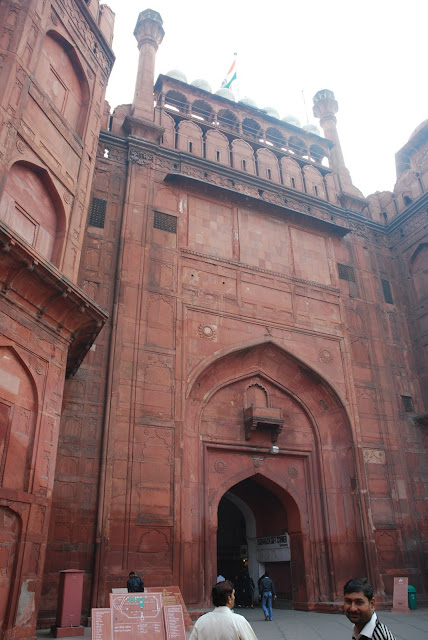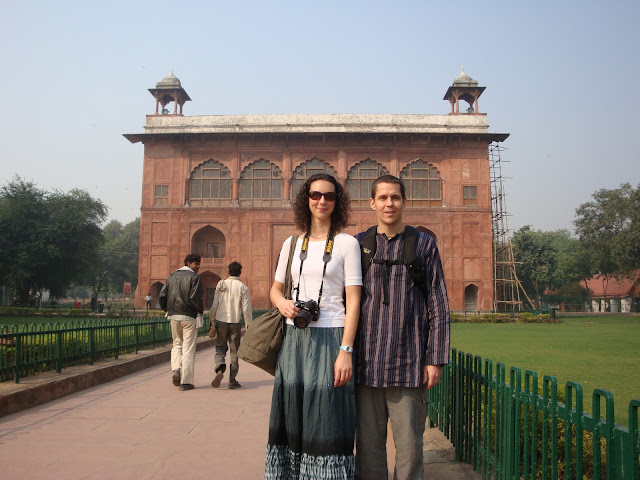Sunday, December 19, 2010
The Red Fort
(Right from Wikipedia...)
The Red Fort is a 17th century fort complex constructed by the Mughal emperor Shah Jahan in the walled city of Old Delhi (in present day Delhi). At one point in time, more than 3,000 people lived within the premises of the Delhi Fort complex. It served as the capital of the Mughals until 1857, when Mughal emperor Bahadur Shah Zafar was exiled by the British Indian government. The British used it as a military camp until India was made independent in 1947. It is now a popular tourist site, as well as a powerful symbol of India's sovereignty: the Prime Minister of India raises the flag of India on the ramparts of the Lahori Gate of the fort complex every year on Independence Day. It was designated a UNESCO World Heritage Site in 2007.
(Any text italicized below came from Wikipedia as well or from Archeological Survey of India website.)
The driver dropped us off, including our faithful took-took driver turned guide Harish, at the entrance of the Red Fort where we were immediately pounced on by touts of all ages trying to sell us everything from postcards to tiny plastic took-tooks. Thankfully we go through a security gate right away where the touts are left behind and we can breathe easy.
We paid for Harish to accompany us inside the Fort. His entrance fee was 15 rupees (.33 cents) while we were 750 rupees ($16.66 USD).
After going through the typical Indian security (men and women separated, everything searched, body pat-downs) you come to Lahori Gate - the main entrance into the Red Fort.
Lahori Gate leads you to Chatta Chowk, a long covered bazaar "street" which is now basically just a bunch of stalls selling touristy stuff. But the design of this vaulted arcade is quite striking in a very simple way.
The Chatta Chowk leads to Naqqar-Khana (Drum-house), where ceremonial music was played and which also served as the entrance to the Diwan-i-'Am (explained below). Its upper story is now occupied by the Indian War Memorial Museum. Honestly, I found the museum boring, although I did find it amusing to see Indian tourists taking photos of us. And quite openly... they didn't hide the fact they were snapping photos of us white folk.
Take a closer look at the scaffolding... OSHA would have a field day with this...
From this gate you come to a large open area which once served as the courtyard for the Diwan-i-'Am - the building where the emperor would come out on his big throne and speak to his subjects. Below is the throne.
The Diwan-i-' Am (Hall of Public Audience) is yet another amazing structure that is still standing after all these centuries later. It is a "rectangular hall, three aisle deep, with a façade of nine arches. At the back of the hall is an alcove, where the royal throne stood under a marble canopy."
G in front of a neat looking tree:
There are several other buildings of importance, but I don't want to bore anyone with too many photos, so I'll mention one last building - the imperial private apartments. These "apartments" consist of a row of pavilions connected by a continuous water channel, known as the Nahr-i-Behisht (Stream of Paradise). The water is drawn from the river Yamuna, from a tower, the Shah Burj, at the north-eastern corner of the fort. The palace is designed as an imitation of paradise as it is described in the Koran; a couplet repeatedly inscribed in the palace reads, "If there be a paradise on earth, it is here, it is here".
When we left the Red Fort we were once again mobbed by touts. One followed us all the way to the car... which was quite a hike away and we would not have found it easily if it weren't for Harish.
Subscribe to:
Post Comments (Atom)



















i <3 this blog!!!! i love thinking how the old buildings were beautifully and intricately ornate with out the use of modern machines and tools. amazing attention to detail. kera, why did your guide get such a discount to enter?
ReplyDeleteYeah, it is amazing to look at buildings from hundreds of years ago that were made without modern machinery. And even more amazing they are still standing. If only buildings today were made with such attention to detail.
ReplyDeleteAll Indian nationals received a very discounted rate to get into all the "heritage" type things - Red Fort, Taj Mahal, Agra Fort, etc. Not sure the reasons behind it. Although I'm sure one reason is because many Indians wouldn't otherwise be able to visit these monuments. Twelve American dollars to get into the Red Fort seemed reasonable to us, but to many Indians who may not make $12 in month, that's a ton of money.